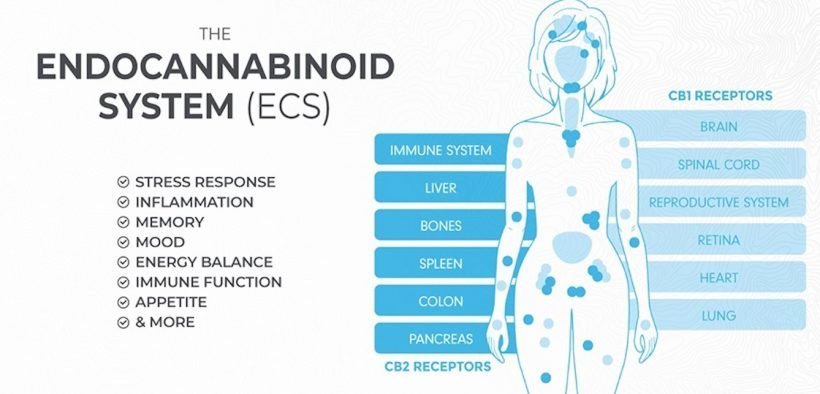An Introduction to the Endocannabinoid System (What is it?)

The ECS maintains our well being by regulating key biological aspects of our body. Most importantly, it plays a central role in keeping our body in homeostasis.
Cannabidiol (CBD) is an effective health supplement because we have an endocannabinoid system (ECS) in our body to interact with it. While the endocannabinoid system’s primary purpose is not to engage with cannabis, it interacts with the cannabis plant similarly to compounds we naturally create in the body.
The relationship between the endocannabinoid system and cannabis is a fairly new area of study, although it has piqued the interest of humans for thousands of years. Before the endocannabinoid system was discovered, humans recognized the influence of cannabis on the human body but could not explain the biological process behind it. The search for understanding of the cannabis plant has lead researchers to discover the endocannabinoid system.
As you research the effect of cannabinoids, you’ll find that cannabis has a considerable influence on the body. To understand how cannabinoids such as CBD interact with the body, we must look at the full picture of the endocannabinoid system.
Homeostasis: A Balancing Act
The ECS maintains our well being by regulating key biological aspects of our body. Most importantly, it plays a central role in keeping our body in homeostasis. In the human body, homeostasis is the maintenance of a constant internal environment despite external changes. This biological state is highly important to the proper functioning of the body.
To work at optimal performance, our cells must work in specific conditions which often fall into a narrow range. The ECS plays a major role in adjusting conditions to fall within this range.
Homeostasis is a balancing act. Similar to a tightrope walker, we are continually being pulled from our point of stability. To maintain a stable environment, the body must constantly regulate several factors and adjust as conditions change.
How the Endocannabinoid System Works
The ECS is made up of three components: cannabinoid receptors, endocannabinoids, and metabolic enzymes. These components are found throughout the body, including the brain, tissues, and organs.
The ECS is a signaling network that uses endocannabinoids to control processes in the body. Endocannabinoids (endo meaning within) are specialized compounds that are synthesized, or created, in the body as needed. When outside homeostasis, the body produces endocannabinoids to reclaim its balance. Endocannabinoids then send information to the cells that gives the cells a specific direction that will result in a return to homeostasis. Let’s take a further look at how this process works.
When unbalanced, the body produces endocannabinoids to send a specific message to the cell. The two major endocannabinoids are anandamide and 2-AG. Endocannabinoids work as messengers to send information through the receptor and into the cell. To do so, they bind to and activate cannabinoid receptors.
Cannabinoid receptors observe the conditions outside the cell and send the information inside the cell. If conditions outside the cell change, the cannabinoid receptors notify the cell which prompts a cellular response. When an endocannabinoid binds to the receptor, the receptor relays the message to the cell. Cannabinoid receptors act as a telephone of sorts, sending a message across the cellular membrane.
The two major cannabinoid receptors are labeled CB1 and CB2. Both are found throughout the body; however, CB1 receptors are more prominent in the brain while CB2 receptors are found in abundance outside the nervous system.
As soon as they have performed their task, endocannabinoids are broken down by metabolic enzymes. The two major metabolic enzymes are FAAH and MAGL. This final process makes sure that endocannabinoids are being used only for as long as they’re needed.
How CBD Interacts with the Endocannabinoid System
Cannabinoids can be created by the body, by plants, and synthetically. CBD and THC are the two main cannabinoids in the cannabis plant that mimic the function of endocannabinoids. In particular, the benefit of CBD has been an interesting area of study as it does not create a high like THC does.

So how does CBD interact with the body? While THC binds to the CB1 receptor directly to create a high, CBD interacts differently with the ECS. Rather than binding to the cannabinoid receptors, CBD indirectly affects the signaling of the CB1 and CB2 receptors. This prevents other compounds from binding to the receptors, which explains how CBD diminishes the effect of THC, as it inhibits THC from binding to cannabinoid receptors. Additionally, CBD inhibits the FAAH enzyme from breaking down anandamide, which allows for a greater prevalence of the endocannabinoid in the body.
CBD interacts with a number of different receptors and therefore has been studied for various therapeutic benefits. There are exciting possibilities of what this can mean for health and wellness. As of now, we know that CBD is of benefit for maintaining wellness. We encourage you to research the many other benefits of CBD.







